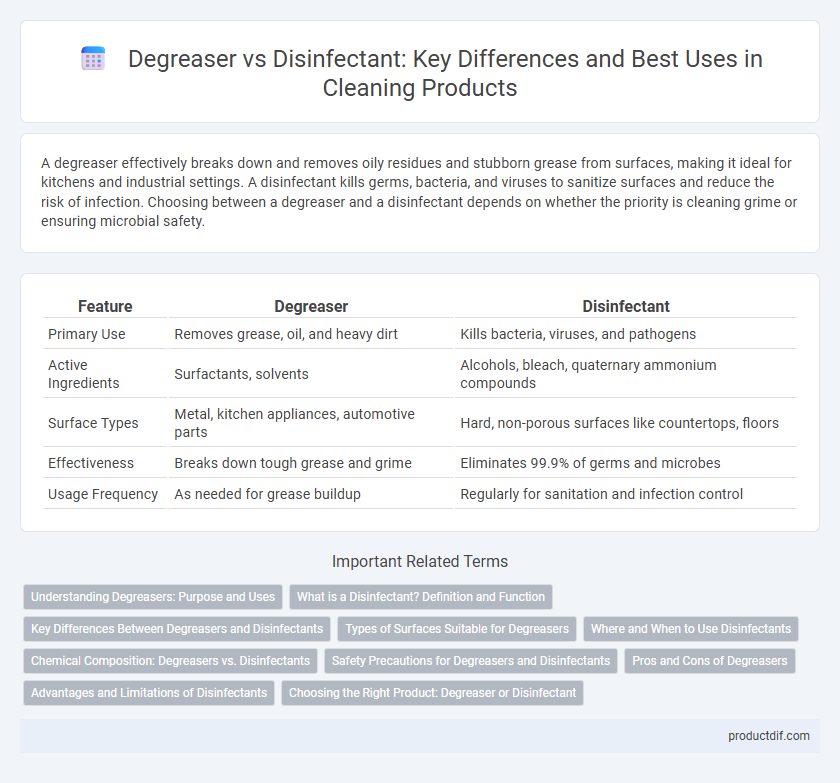A degreaser effectively breaks down and removes oily residues and stubborn grease from surfaces, making it ideal for kitchens and industrial settings. A disinfectant kills germs, bacteria, and viruses to sanitize surfaces and reduce the risk of infection. Choosing between a degreaser and a disinfectant depends on whether the priority is cleaning grime or ensuring microbial safety.
Table of Comparison
| Feature | Degreaser | Disinfectant |
|---|---|---|
| Primary Use | Removes grease, oil, and heavy dirt | Kills bacteria, viruses, and pathogens |
| Active Ingredients | Surfactants, solvents | Alcohols, bleach, quaternary ammonium compounds |
| Surface Types | Metal, kitchen appliances, automotive parts | Hard, non-porous surfaces like countertops, floors |
| Effectiveness | Breaks down tough grease and grime | Eliminates 99.9% of germs and microbes |
| Usage Frequency | As needed for grease buildup | Regularly for sanitation and infection control |
Understanding Degreasers: Purpose and Uses
Degreasers are specialized cleaning products formulated to break down and remove heavy grease, oils, and stubborn dirt from surfaces such as kitchen appliances, automotive parts, and industrial equipment. These products contain powerful solvents or surfactants that effectively dissolve greasy residues but do not necessarily kill bacteria or viruses. Understanding the specific function of degreasers helps in selecting the right product for tasks that require intense grease removal rather than disinfection.
What is a Disinfectant? Definition and Function
A disinfectant is a chemical agent designed to eliminate or inactivate harmful microorganisms on surfaces, preventing the spread of infections and diseases. Unlike degreasers that primarily remove grease and grime, disinfectants target bacteria, viruses, and fungi, ensuring sanitized environments in homes, hospitals, and food processing areas. Effective disinfectants often contain active ingredients such as quaternary ammonium compounds, bleach, or hydrogen peroxide, which disrupt microbial cells and neutralize pathogens.
Key Differences Between Degreasers and Disinfectants
Degreasers are specialized cleaning agents formulated to break down and remove oils, grease, and heavy dirt from surfaces, primarily targeting grime and residue. Disinfectants, on the other hand, contain antimicrobial agents designed to kill or deactivate bacteria, viruses, and fungi, ensuring hygienic and pathogen-free environments. Unlike disinfectants, degreasers do not have significant antimicrobial properties, making them ideal for surface cleaning but not for sanitization purposes.
Types of Surfaces Suitable for Degreasers
Degreasers are highly effective on non-porous surfaces such as kitchen countertops, stainless steel appliances, and cookware where grease buildup is common. They also work well on automotive parts and industrial machinery, dissolving oil and grime without damaging the surface. Unlike disinfectants, degreasers do not kill bacteria but specialize in removing oily residues to prepare surfaces for further sanitization.
Where and When to Use Disinfectants
Disinfectants are essential for sanitizing high-touch surfaces such as doorknobs, countertops, and bathroom fixtures, especially in healthcare settings, kitchens, and bathrooms where germs and bacteria are prevalent. They should be used after cleaning to eliminate pathogens and reduce the risk of infections on surfaces contaminated by viruses, bacteria, or fungi. Disinfectants are most effective in environments requiring strict hygiene standards, such as hospitals, schools, and food preparation areas, where preventing cross-contamination is critical.
Chemical Composition: Degreasers vs. Disinfectants
Degreasers typically contain surfactants, solvents, and alkaline agents designed to break down oils and grease by emulsifying fatty substances. Disinfectants rely on chemical compounds such as quaternary ammonium compounds, chlorine, or alcohols to eliminate harmful microorganisms and sanitize surfaces. Understanding the distinct chemical compositions is crucial for selecting the appropriate cleaning product based on whether the priority is removing grease or ensuring surface disinfection.
Safety Precautions for Degreasers and Disinfectants
Degreasers require careful handling due to their strong chemical formulations, mandating the use of gloves, eye protection, and adequate ventilation to prevent skin irritation and respiratory issues. Disinfectants must be used following manufacturer guidelines to avoid toxic exposure, ensuring surfaces are rinsed if needed and keeping products away from food and children. Both products should be stored securely in labeled containers to maintain safety and effectiveness during cleaning tasks.
Pros and Cons of Degreasers
Degreasers effectively break down and remove tough grease, oil, and grime, making them ideal for kitchen and industrial cleaning applications. However, many degreasers contain strong chemicals that can irritate skin and damage certain surfaces if not used properly. Their primary limitation is that while they excel at grease removal, they do not kill bacteria or viruses, unlike disinfectants.
Advantages and Limitations of Disinfectants
Disinfectants effectively eliminate harmful microorganisms, making them essential for maintaining sanitary environments in healthcare and food preparation areas. They offer rapid antimicrobial action against bacteria, viruses, and fungi but may not remove dirt or grease, necessitating prior cleaning with degreasers for optimal results. Some disinfectants can cause surface corrosion or leave residues, requiring careful selection and usage according to compatibility and safety guidelines.
Choosing the Right Product: Degreaser or Disinfectant
Choosing the right cleaning product depends on the specific task: degreasers are formulated to break down stubborn grease, oils, and heavy grime, making them ideal for kitchen surfaces and machinery. Disinfectants target and eliminate bacteria, viruses, and fungi, ensuring surfaces are sanitized and safe, crucial in healthcare settings and bathrooms. Selecting between a degreaser or disinfectant requires assessing whether grease removal or microbial elimination is the primary goal.
Degreaser vs Disinfectant Infographic

 productdif.com
productdif.com